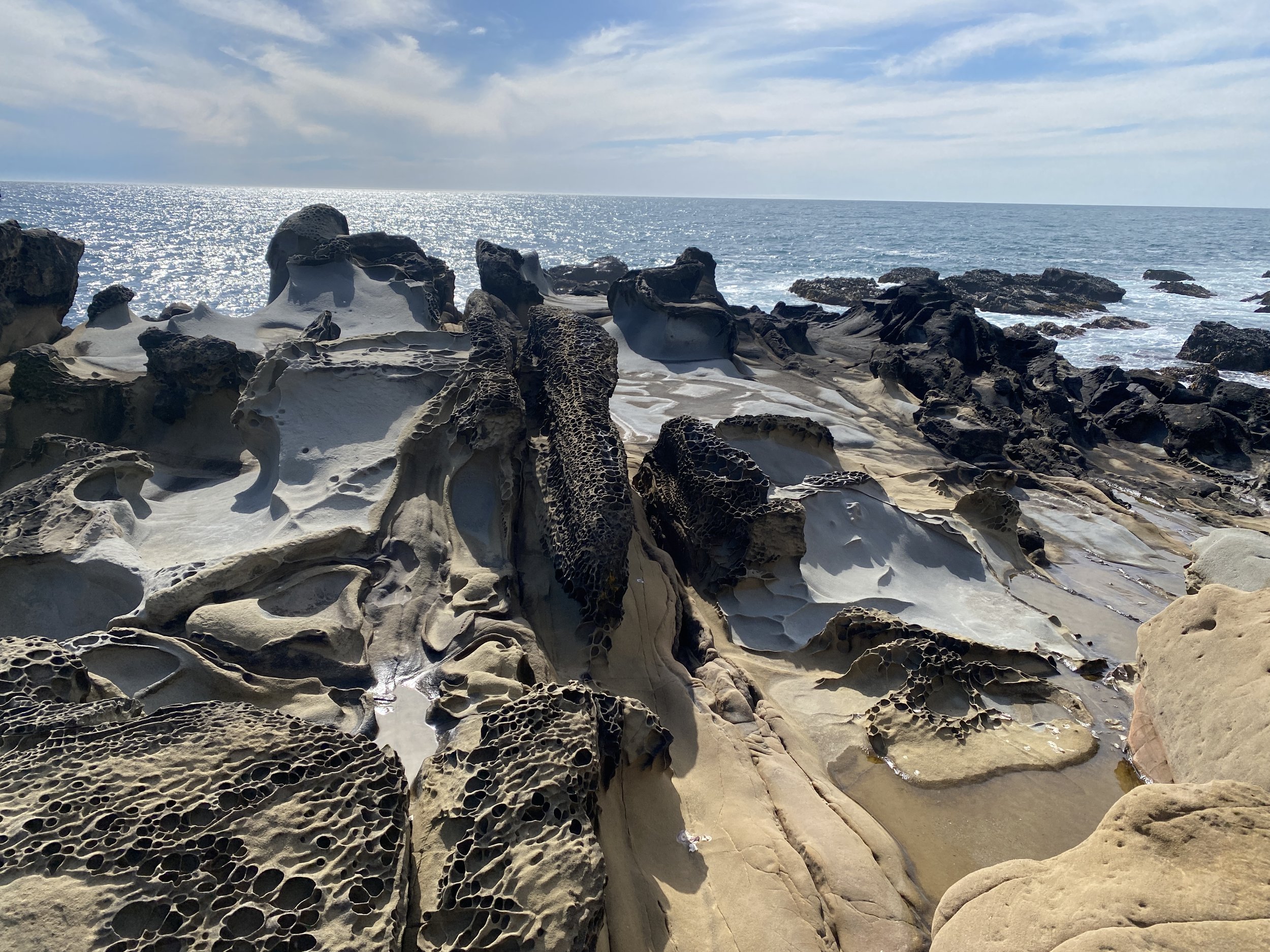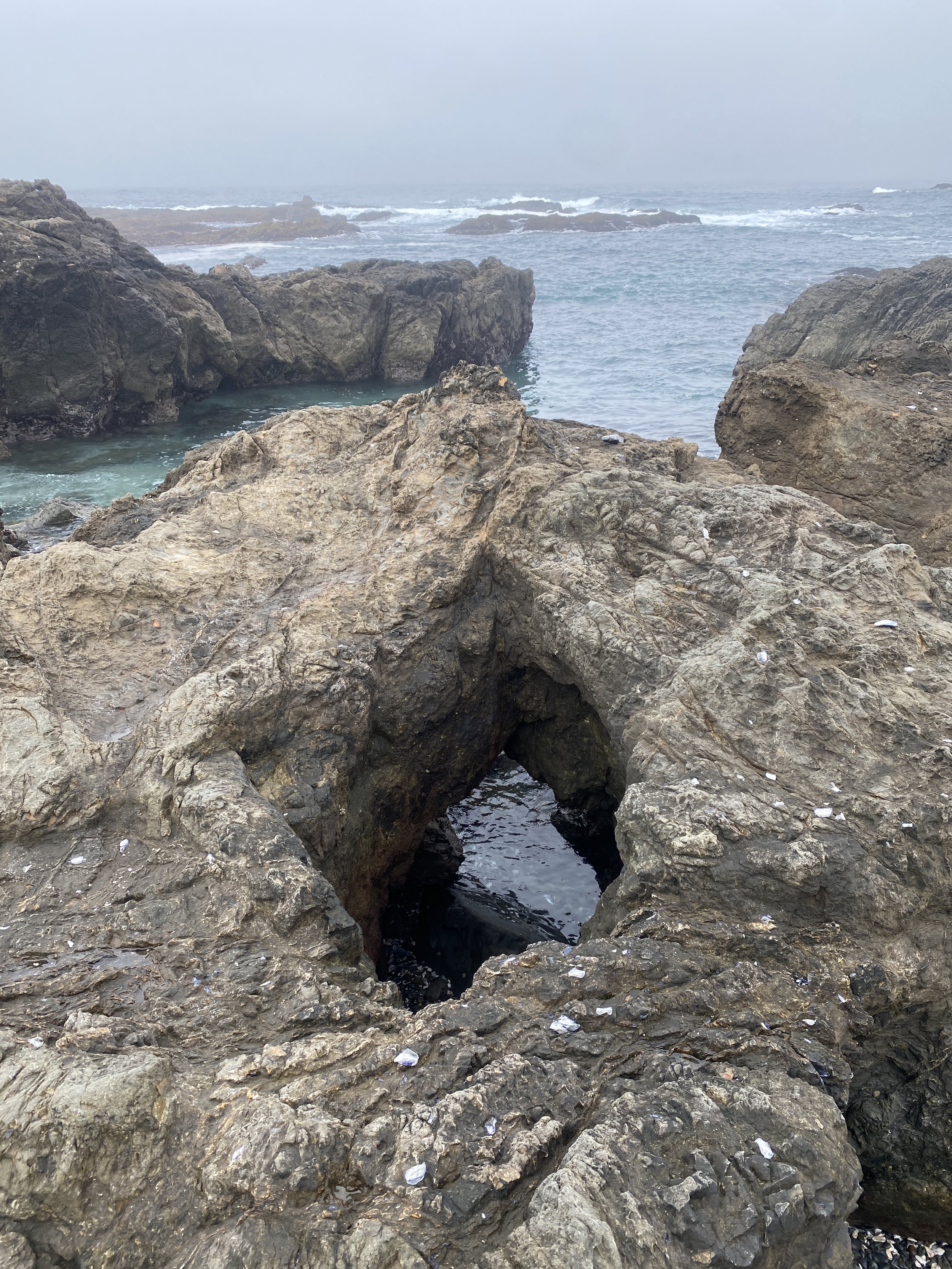Week 13 - Visual Research & Wood Fire Unload
I’ve spent this entire week exploring and relaxing in nature. For the first time in a while, I spent a couple days doing nearly nothing. I’ve got a hectic end of the semester ahead, what with moving out of my apartment and finishing up my time at IUS. I’ll be spending my summer at Touchstone School of Crafts in Farmington Pennsylvania doing an internship starting in June that will end right before I make the move to California, and I’ve got a lot to wrap up before then. So the time to just chill in solace, with no other immediate obligations, was a gift.
I found a beautiful primitive campsite overlooking Clear Lake — the only one on that side of the mountain — and stayed there for three nights, listening to audio books, sculpting a little, and enjoying the scenery and quiet.
On Thursday, I packed up camp and headed down (and up) some very windy roads towards the coast. I drove along the Sonora Coast on Highway 1 and saw so many incredible views of the ocean (!!!!!!!! THE OCEAN !!!!!!!!), before stopping at Gerstle Cove in Salt Point State Park to see some insane rock formations.
The otherworldly terrain formed by the tafoni-weathered sandstone slabs and solidified rivers of ancient rock flow was mindblowing. I was surprised by the range of colors and textures (darker areas are from iron oxide leaching through the surface), and also how strong the sandstone was (I found some awesome places to perch and hang from).
…geology spiel incoming … trying to paraphrase what I’m learning…
This area is an uplifted, submarine basin formed 40-60 million years ago and has since moved 200-260 miles north by the San Andreas fault. It’s a sliver of continental crust attached to the Pacific Ocean plate, called the Salinian block, and is moving northwest along the San Andreas fault. The rocks I explored are part of the German Rancho formation, composed of sedimentary rocks; mainly sandstone with layers of conglomerate and mudstone. They are solidified currents of dense, sediment-laden water that flowed down a submarine canyon, called “turbidity currents,” to the ocean floor, deposited into a massive deep-sea fan. At the top of the fan, the sediment is courser and gets finer as it travels down the fan’s channels — the sandstone beds of Salt Point are thought to be formed in these channels and then raised and tilted from earthquakes/plate movement. (https://www.saltpoint.org/geology)
The seemingly infinite tafoni weathering is initiated by salt spray dislodging sand grains in the rock, but the exact processes of tafoni are apparently unknown — which I didn’t know, and it’s a fact I’m enthralled by that affirms much of my fascination and focus on these forms.
After observing tafoni here and at Arches, I’ve got a much better understanding of its patterns. It was wild seeing extreme examples of the weathering mirror moments in my own forms that I’d intuitively sculpted…
I think these are the craziest rocks I’ve ever seen. I kept wondering to myself if I was dreaming or hallucinating because it felt so unreal to be climbing over the rocks I’ve been studying via internet search and printed photos on my studio wall for the past two years. I can’t believe how close this geology is to where I’ll be living next year.
The climate, shoreline, rocks, and sea creatures reminded me a lot of Vancouver Island. I felt like a kid again exploring the tide pools and discovering hidden caves and tunnels in the rocks.
Those photos were taken in MacKerricher State Park, about 20 minutes north of Mendocino. I car-camped Thursday night outside the Mendocino Art Center after getting a nice tour of the studio and reconnecting with some folks I’d met at NCECA. It’s a lovely space situated in downtown Mendocino, a sweet, itty-bitty, touristy coastal town. They’ve got some great kilns that aren’t being fired to their full potential. I’d never seen a top-loading train kiln in person before, or a full catenary arch kiln for that matter. I’m not sure I could see myself living here, but it is an opportunity to consider. Doing a wood firing with them at some point would be a lot of fun. Regardless, I’m not done exploring this incredible coastline.
The firing at Cobb wrapped up Monday evening. I worked the 4-10am Monday morning and we struggled to maintain temperature for most of the shift. We’d switched to burning only eucalyptus, and the first overnight shift had trouble keeping it at temperature, too. I enjoyed troubleshooting with Syd, a wood-fire resident who will be staying another year, and learning more of the kiln’s intricacies. We eventually found success with closing the damper a small bit to push some heat up front, along with keeping the front door closed for the majority of the time between stokes. Towards the end of our shift, Scott came and fluffed the coals and brought the front back to temperature. A couple hours later, the afternoon team stopped stoking the front and switched to side-stoking for remainder of the firing.
After 4 days of cooling, we unbricked the kiln…
Those pieces in the coal bed fell during the firing - either from the earthquakes or being hit during side stoking.
The unload was a ton of fun— we each guessed how many pieces were in the kiln and donated a pot of our own to a pool that everyone got to choose a new pot from, in order of who guessed closest. There ended up being 450 something pieces!! I guessed severely low and was third-to-last to pick but was still very happy with the pot I ended up with. Either way I was pretty honored that my pot was the first one picked out of the bunch — at least I had that going for me.
I got a lot of useful information from this firing. All the pots in the back of the kiln were noticeably dryer (less ash) with a metallic orange sheen. The pieces closest to the back coal bed had some weird, “glitzy” crawling that was likely caused by too sudden cooling paired with prolonged heavy reduction. I wasn’t thrilled with how my pots in this area of the kiln turned out. There was little to no ash build up and my shino liner, which usually goes white/pink/blue when I soda fire it, went pure orange in the heavy reduction atmosphere.
Here are some favorable moments:
11 was down everywhere in the kiln and 12 was soft. Scott said that if he were to do anything different, he would have had the damper in a bit more and downfired for 4-6 hours at the end to drop the temperature gradually. There was definitely a unique effect from the eucalyptus wood ash — it pools a milky white with variations of blue and yellow.
The main takeaway for me is that I need to find a strong claybody that is more refractory and won’t start to dunt when it gets above cone 10 in reduction atmospheres. It went too dark for my liking and didn’t showcase the ash and flashing as well as the lighter stonewares in the kiln. In heavy reduction it loses all nuance and becomes a shiny deep red/brown. I want a lighter, more matte canvas that flashes more dramatically, so I plan to try out some recipes without redart and stick to a Hawthorne/ball clay/kaolin base with varying sizes of grog. Casey’s been using one of his own recipes (unreleased sadly) that flashes yellow, and I’m obsessed with it. So I might try adding calcium (causes the yellow) to my clay tests, or slips.
I loved how my vases with the unprocessed native clay slips turned out. They were towards the front of the kiln, so it’s hard to say what was the clay and what was the ash. I’m looking forward to continuing with wild clay slips/terra sigs while I’m at Cobb.
The little native clay tests I threw in there were interesting— the Utah clay completely melted into a glittery green pool, and the clay from the Cobb property fluxed a bit but kept form. I want to test the Utah clay at lower temps and find its melting point and then formulate a glaze using it and wood ash (though I sadly only have a small bit of it to work with).
Apologies for the massive blog. Lots of thoughts this week. I’m finishing writing this in Santa Fe, on my way back to Kentuckiana. This trip has been pivotal for me in a lot of ways. I’m feeling almost overwhelmed with the amount of visual inspiration I’ve gathered, and I’ve grown super curious about the earth/geology around me. Very excited for the direction my work is headed now, and so, so grateful for this time I carved out for myself to explore.














































